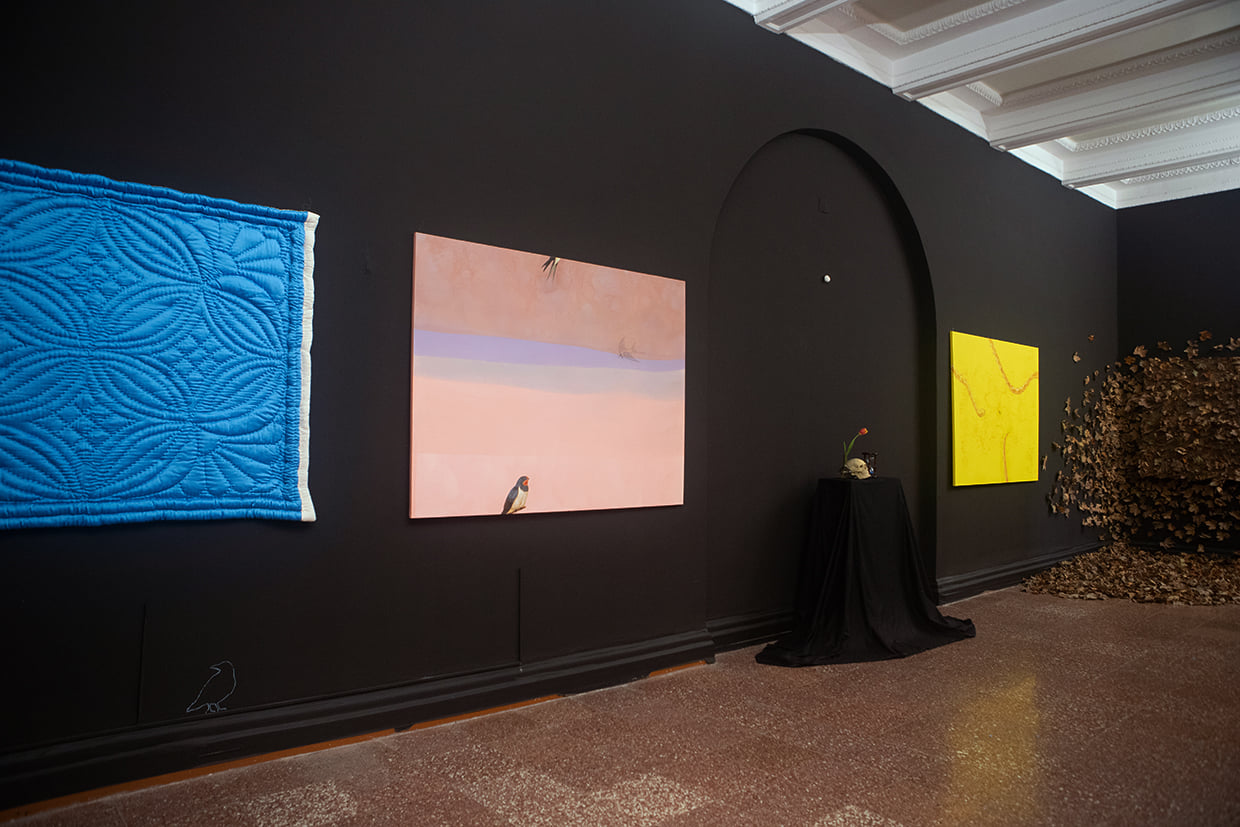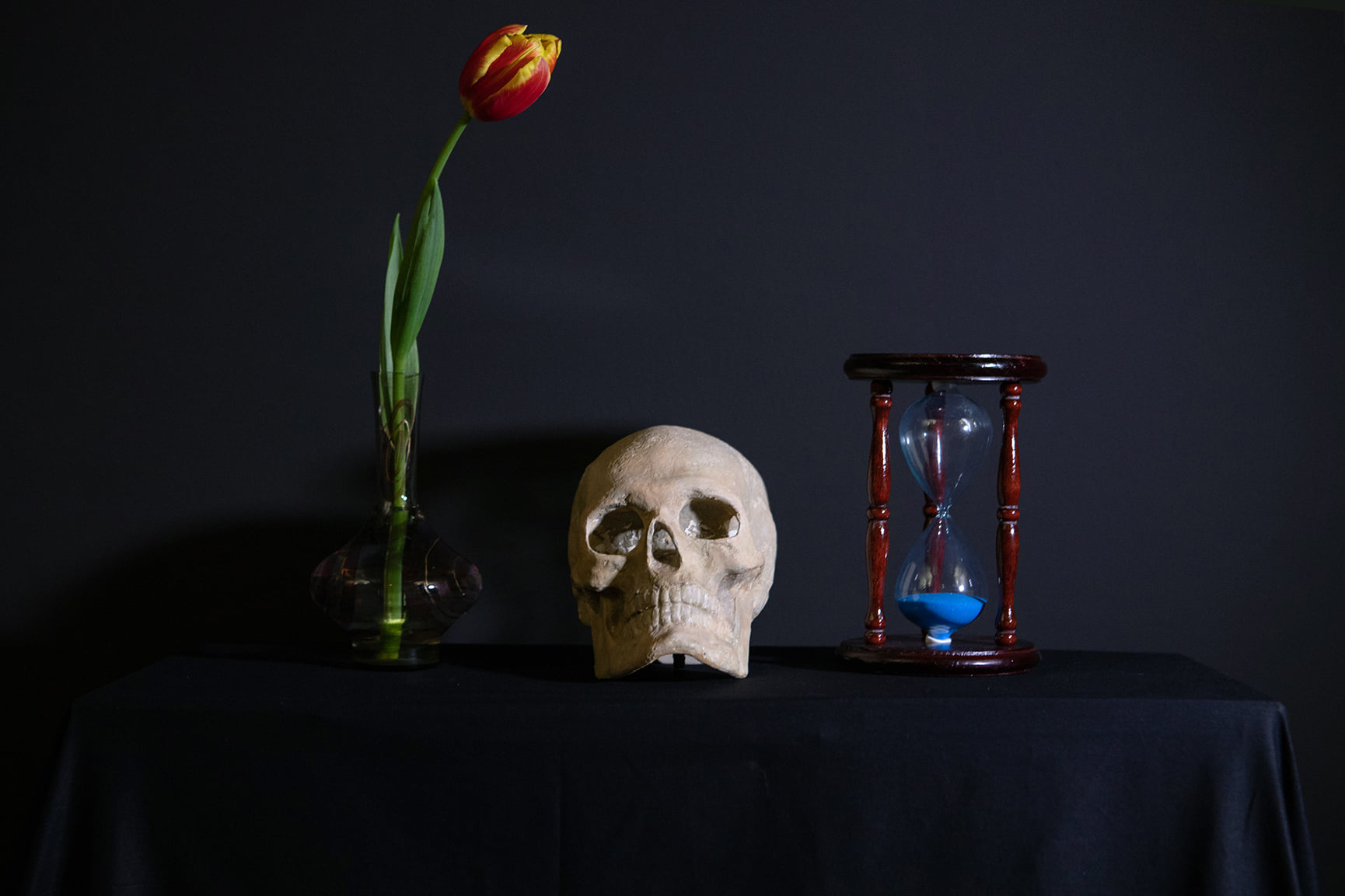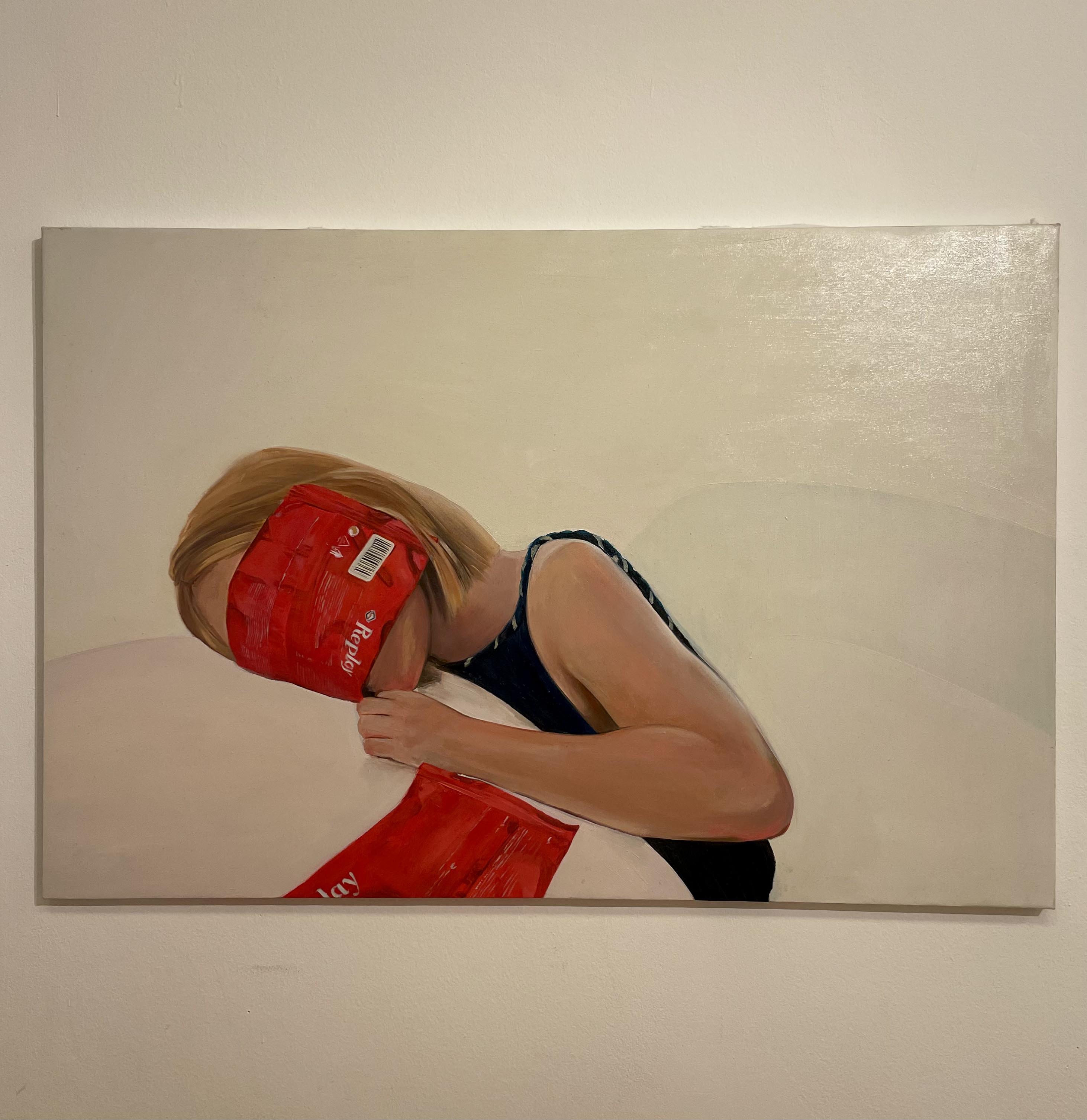
Exhibition / Oltsen Gripshi / “The seasons of being or the hymn of life” / Ministry of Culture / January 27th – February 28th 2021 / Tirana
Contemporary artist Oltsen Gripshi opened his solo exhibition “Seasons of being or the hymn of life” in the art pavilion at the Ministry of Culture in Tirana, starting from January 27th – February 28th, 2021. We recall that the project “Pavilion – Art in Public Institutions” is an initiative of the Ministry of Culture.
The exhibition, consisting of paintings and installations, was based mainly on figures of symbolism and parallelism. Metaphorically, the title “Seasons of being or hymn of life” reminds us of the analogy between the natural and vital seasons of man from birth to death; consequently, we seek our representation in art through them. Thus, the artistic journey in the exhibition started with the winter season, which was represented by a completely unused family item, one of the few saved items from the collapse of the author’s own house, after the seismic shock in Albania on November 26th, 2019.
Although the starting point of this exhibition is precisely a severe natural phenomenon (the earthquake), the author’s artistic counteraction comes as an encouragement for self-recovery. The strong, vivid colors used in the exhibition for each season respectively, proved that a shock of this kind, so extensive (physically, spiritually, morally, economically) does not represent an end, an irreversible overturn; nor should it be seen as such. It was a shock, which must be followed by resurgence as a contraposition to our common drama. Pieces saved from the collapse, such as a hand-crafted cover, serve as an incitement for the artist to “interlace” a seasonal journey through visual art, which is related to both one’s personal human journey and that of the society as a whole; thus, with cracks, breaks, dramas, but just as much with inspiration and strength to regain vitality, in this case, through colors and signs (symbols).
When just a few objects are left after the seismic shock, inherited these from blood relations, then they are no longer merely objects; they are fragments from the past, memories’ stimulators with high spiritual heaviness in terms of strong blood connection, of the land where a human was born, raised and where they worked / created; thus, in this case, such a simple thing becomes a catalyst between a human and his roots, so important for the qualitative and meaningful inheritance of life. Already, the satin blue cover carries the bittersweet taste of the beloved past and of that dramatic past, the earthquake.
Chronologically, the seasons are listed one after the other, followed by winter with spring and summer which come through the genre of painting. The picture of spring (or spiritual revival and not only spiritual), in addition to the vibrancy of colors, contains the faithful herald of the season, the swallow, in this case decomposed in the picture, while the summer picture shines from the strong yellow and in its content are the typical animal representatives of this season (the snake and the fly). Just like winter, autumn comes to the exhibition through installation; the winter blue cover also resembles a picture; while the autumn picture is shaped with leaves which fill it and scatter everywhere around it. The peculiarity in the autumn season lies in the fact that the visitor, on the run, can take with him a part of it.
There is a general opposition to the bad things in this exhibition. Thus, the creations of the exhibition contrast with the dark background (in black) in which they are placed and created in such a way that the interaction between them and the viewer is as close and strong as possible. None of the elements used, except the background, seem to come in negative nuances. There is no conclusive definition that the raven, the snake, and the fly (elements used in the exhibition for symbolic purposes) come in negative nuances, respectively: ominous, insidious, or annoying. They may think about the solitary moment (through the raven), the protection of the possessed space or the elasticity and strength while facing difficult situations (through the serpent), and also the insistence “to be”, “to face”, rising above the disabilities and extremely small sizes (through the fly).
The whole exhibition is in itself a large installation that includes smaller installations, among which the nucleus is the installation trinomial consisting of: the tulip – the mark of life, of beauty, of fragility and of temporality; the skull – a sign of death, consequently, of fear, ugliness, anxiety; and the sand time meter (our meter, because time is infinite), which leads us to the thought of the infinity of time. And in the center, above everything, an egg is exposed as a sign of the origin of the being. The exhibition, in which the content and the aesthetic side are closely intertwined and put at the service of each other, is a reflection of self-cognitive experiences, an invitation to the viewer for a process of self-cognition as well. The strong connection of the human being with animal beings, with natural phenomena, that is, with nature in general it’s so conspicuously present.
The exhibition, based on the feeling of remembering / reliving the pain on one hand and awakening hope on the other, created with signs (symbols) – each of which is a stimulus to the thought of the continuity of life, overcoming natural and social obstacles – intended to raise an anthem to life, despite the difficulty of each season, precisely thanks to the connection that the human being tries to establish with the place and time through which he travels and leaves his mark.
***
Ekspozitë / Oltsen Gripshi / “Stinët e qenies apo himni i jetës” / Ministria e Kulturës / 27 janar – 28 shkurt 2021 / Tiranë
Artisti bashkëkohor Oltsen Gripshi hapi ekspozitën vetjake “Stinët e qenies apo himni i jetës” në pavijonin e artit në Ministrinë e Kulturës në Tiranë, në hapësirën kohore 27 janar – 28 shkurt 2021. Rikujtojmë, projekti “Pavijoni – Art në Institucionet Publike” është nismë e Ministrisë së Kulturës.
Ekspozita, e përbërë nga piktura dhe instalacione, bazohej kryesisht mbi figurat e simbolit dhe paralelizmit. Metaforikisht, titulli “Stinët e qenies apo himni i jetës” na ndërmend përngjasimin midis stinëve natyrore dhe atyre jetësore të njeriut, nga lindja deri në vdekje; për rrjedhojë, edhe ne kërkojmë përmes tyre përfaqësimin tonë në art. Kështu, rrugëtimi artistik në ekspozitë niste me stinën e dimrit, e cila përfaqësohej nga një send vetjak familjar krejt i papërdorur, një nga të paktat sende të shpëtuara nga rrënimi i shtëpisë së vetë autorit, pas tronditjes sizmike të Shqipërisë më 26 nëntor 2019.
Ndonëse pikënisje e kësaj ekspozite është pikërisht një dukuri e rëndë natyrore (tërmeti), kundërveprimi artistik i autorit vjen si një nxitje për rimarrje të vetvetes. Ngjyrat e forta, të gjalla, përdorur në ekspozitë, përkatësisht për çdo stinë, dëshmonin se një tronditje e kësaj natyre, kaq gjithëpërfshirëse (fizike, shpirtërore, morale, ekonomike) nuk përbën një fund, një përmbysje të pakthyeshme; dhe as që duhet parë si e tillë. Ishte një tronditje, e cila duhet të pasohet nga ringritja, si një kundërvënie ndaj dramës sonë të përbashkët. Copëza të shpëtuara nga shembja, siç është një mbulojë e punuar me mjeshtëri dorazi, i shërbejnë artistit si shtysë për të “thurur” përmes artit pamor një rrugëtim stinor, i cili lidhet sa me udhëtimin vetjak njerëzor, po aq edhe me atë mbarëshoqëror; pra, me krisje, thyerje, drama, por po aq me frymëzim dhe forcë për të rigjetur gjallërinë, në këtë rast, përmes ngjyrave e shenjimeve (simboleve).
Kur pak sende ngelen pas tronditjes sizmike, trashëguar këto nga marrëdhënie me lidhje gjaku, atëherë objekte të tilla nuk janë më thjesht sende; janë copëza nga e kaluara, ngacmuese kujtimesh me ngarkesë të lartë shpirtërore për sa i përket lidhjes së fortë të gjakut, të truallit ku njeriu është lindur, rritur dhe ka punuar/krijuar; pra, në rastin në fjalë, një send kaq i thjeshtë shndërrohet në një katalizator midis njeriut dhe rrënjëve të veta, kaq të rëndësishme për trashëgimin cilësor dhe kuptimplotë të jetës. Tashmë, mbuloja e atllastë blu mbart shijen e ëmbël e të hidhur të së kaluarës së dashur dhe të asaj të kaluare dramatike, tërmetit.
Kronologjikisht, stinët renditen njëra pas tjetrës, duke vijuar pas dimrit me pranverën dhe verën të cilat vijnë përmes gjinisë së pikturës. Tabloja e pranverës (ose ringjallja shpirtërore dhe jo vetëm shpirtërore), përpos gjallërisë së ngjyrave, ka në përbërje lajmëtaren besnike të stinës, dallëndyshen, në këtë rast e shkompozuar në tablo, kurse tabloja e verës vezullon nga e verdha e fortë dhe në përmbajtje të saj qëndrojnë përfaqësueset tipike shtazore të kësaj stine (gjarpri dhe miza). Ashtu si dimri, edhe vjeshta vijnë në ekspozitë përmes instalacionit; mbuloja blu e dimrit përngjet edhe si tablo; ndërsa tabloja e vjeshtës është formësuar me gjethe të cilat e përmbushin atë dhe shpërhapen anekënd rreth saj. Veçantia në stinën e vjeshtës qëndron në atë se vizitori, në ikje, mund të marrë me vete një pjesëz prej saj.
Ka një kundërvënie të përgjithshme ndaj së keqes në këtë ekspozitë. Kështu, krijimet e ekspozitës i kundërvihen sfondit të errët (në ngjyrë të zezë) në të cilin janë vendosur dhe janë krijuar në atë mënyrë që ndërveprimi mes tyre dhe shikuesit të jetë sa më i afërt, sa më i fortë. Asnjë nga elementet e përdorura, përpos sfondit, nuk duket se vjen me ngjyresa negative. Nuk ka një përcaktim përmbyllës se korbi, gjarpri dhe miza (elemente të përdorura në ekspozitë me qëllim simbolik) vijnë me ngjyresa negative, përkatësisht: ndjellakeq, tinëzar apo bezdisëse. Fare mirë ata mund të ndërmendin: çastin vetmitar (përmes korbit), mbrojtjen e hapësirës në zotërim apo elasticitetin dhe forcën në përballje me gjendje të vështira (përmes gjarprit), pse jo edhe këmbënguljen “për të qenë”, “për të bërë ballë”, duke dalë përmbi aftësitë e kufizuara dhe përmasat tejet të vogla (përmes mizës).
E gjithë ekspozita është në vetvete një instalacion i madh që përfshin instalacione më të vogla, ndër të cilat bërthama është trinomi instalativ përbërë nga: tulipani – shënjim i jetës, i së bukurës, i brishtësisë dhe i përkohshmërisë; kafka – shënjim i vdekjes, për pasojë, i frikës, i së shëmtuarës, i së ankthshmes; dhe matësi i kohës prej rëre (matësi ynë, sepse koha është e pafundme), i cili na çon te mendimi i pambarimësisë së kohës. Dhe në qendër, përmbi gjithçka, qëndron një vezë, si shenjëz e prejardhjes së qenies. Ekspozita, në të cilën ana estetike dhe ajo përmbajtësore ndërthuren ngushtësisht dhe vihen në shërbim të njëra-tjetrës, është një pasqyrim i përvojave vetënjohëse, një ftesë ndaj shikuesit për proces vetënjohjeje po ashtu. Është e pranishme kaq dukshëm në të lidhja e fortë e qenies njerëzore me gjallesat shtazore, me dukuritë natyrore, pra, me natyrën në përgjithësi.
Ekspozita, bazuar mbi ndjenjën e rikujtimit/ripërjetimit të dhimbjes nga njëra anë dhe zgjimit të shpresës nga ana tjetër, e mbarsur në shenja (simbole) – secila prej të cilave përbën një nxitës drejt mendimit të vijueshmërisë së jetës, duke kapërcyer pengesat natyrore dhe ato shoqërore – synonte t’i ngrinte një himn jetës, pavarësisht vështirësisë së çdo stine, pikërisht falë lidhjes që përpiqet të krijojë qenia njerëzore me vendin dhe kohën nëpër të cilët rrugëton dhe lë gjurmën e vet.





